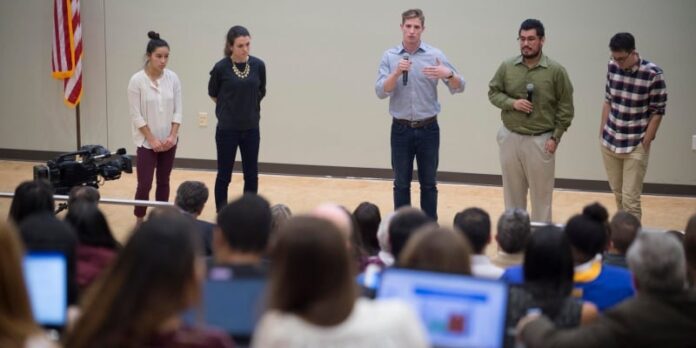
Good ideas are slumbering in intellectual property offices at universities across the country, just waiting for enterprising people to see their potential.
But selecting a good idea and creating a business for it requires a combination of biomedical, technology, and marketing knowhow — a challenge facing Virginia Tech students from the colleges of business and engineering and the translational biology, medicine, and health graduate program.
For the third straight year, the students are teaming up to pitch commercialization ideas. This year’s biomedical “shark tank”-style competition, called the HS&T Hokie Pitch because of its focus on health sciences and technology, will be at the Virginia Tech Carilion Research Institute (VTCRI) on Nov. 30.
The exercise will simulate the commercialization of products in the biomedical and health sciences spaces.
“For the most part, people believe a great discovery is made in a laboratory and somehow people run to it and say, ‘Oh yes, this needs to be turned into a fantastic product that’s useful to people’s lives’,” said Rob Gourdie, a professor at the VTCRI who planned the commercialization exercise with Mark Van Dyke, an associate professor in the Department of Biomedical Engineering and Mechanics (BEAM) in the College of Engineering; and Derick Maggard, executive director of the APEX Systems Center for Innovation and Entrepreneurship in the Pamplin College of Business.
Teams will compete for $9,000 in prize money provided by the Virginia Tech Carilion Research Institute, Luna Innovations Inc., Carilion Clinic, the Apex Systems Center for Innovation and Entrepreneurship, and the Woods Rogers law firm.
“The fact is, most inventions go nowhere from the laboratory because the translation of an idea into a real product in the real world is a complex and involved process,” Gourdie said. “We’re trying to teach students the machinery of how a laboratory invention turns into a patent, which is then licensed and developed by a company as a biomedical technology. Many students don’t know a whole mechanism exists for this purpose.”
The biomedical technology commercialization module is built into the translational biology, medicine, and health (TBMH) graduate program’s gateway class, led by Michael Friedlander, executive director of the Virginia Tech Carilion Research Institute and vice president for health sciences and technology at Virginia Tech.
“Within the Virginia Tech environment, we can bring together teams of business students, engineers, and biomedical scientists to work together,” Friedlander said. “These are the types of interdisciplinary groups that students will be involved with in the workplace. We want them to experience what it’s like to work with people with different career aspirations and different motivations.”
Throughout the gateway course, TBMH graduate students learn about contemporary translational research advances in neuroscience; immunology-infectious disease; metabolic and cardiovascular science; cancer; and development, aging, and repair.
At the end of each topic area, they also learn about examples in the implementation of this science into practice and how to go about commercialization of discoveries in these areas, including the development of intellectual property, regulatory affairs, clinical trials, venture capital, and starting up a business.
Then, together with the business and engineering students, they work in teams to identify promising intellectual property in the health sciences and develop plans for commercializing that property.
“We join students together from different disciplines into teams because they’re not meant to do this alone,” said Van Dyke. “They each have their own strengths and skill sets. Together they really form this cross-curricular experience that brings business, biomedical engineering, and health care together in a way that creates a startup environment for each team.”
The challenges of interdisciplinary projects are eye-opening.
“Students tend to drift toward their areas of specialty, but they also see how insights can surface when someone with a different perspective works with them on a problem,” said Howard Haines, associate director of Virginia Tech’s Innovate Living-Learning Community. “The experience has really opened a lot of the students’ eyes into different career paths as well as the excitement of entrepreneurship. In fact, a couple of the teams are exploring ways to move forward with their commercialization plans after the pitch competition. Others may have learned that it is not the path for them, but they still speak to how much they’ve grown through the process.”
The interaction reaches outside of the classroom. Van Dyke, Gourdie, and Haines regularly gather with students for pizza with real-world experts to talk about business, intellectual property, and the law.
“With some overlap, biomedical scientists and engineers obviously are interested in discovery and research, and business folks are interested in creating commercial opportunities,” Gourdie said. “They have different incentives, and we have created a space for students to learn about people from different academic cultures who may have different career aspirations.”
Judging the presentations will be Friedlander; Maria Clarke, a senior vice president and private client adviser for U.S. Trust and a member of the VTCRI advisory board; Nick Conte, general counsel and senior vice president of Carilion Clinic; Fourd Kemper, a mergers, acquisitions, and venture capital attorney at Woods Rogers law firm; James Garrett, vice president of the technology development division at Luna Innovations; and James Ramey, principal and fund manager of Middleland Capital/VTC Innovation Fund.


